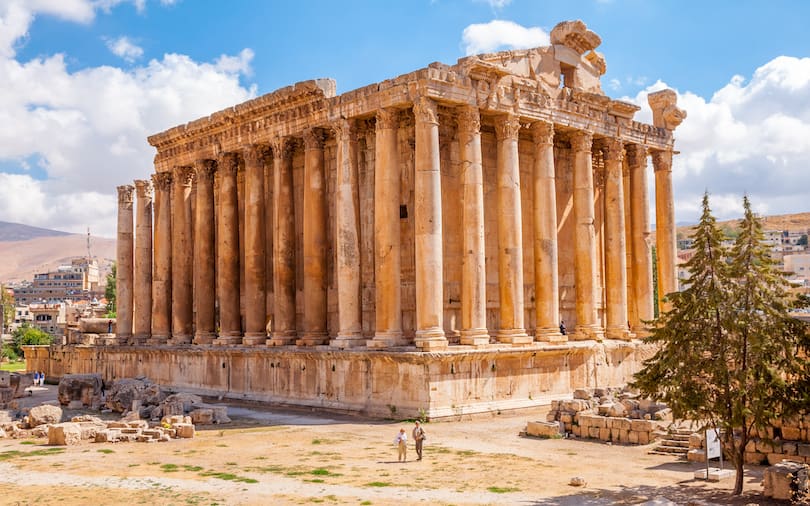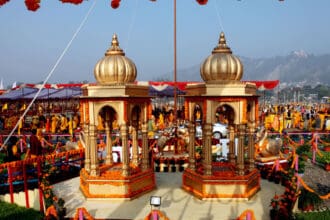Temples have been an integral part of human civilization for thousands of years. They are considered as a sacred place where people come to pray and seek blessings from their deities. With the advancement of architecture and engineering, many magnificent temples have been constructed all over the world. In this article, we will explore the 10 largest temples in the world.
1. Angkor Wat, Cambodia
Angkor Wat is the largest religious monument in the world, located in Cambodia. It was built in the 12th century as a Hindu temple, but later it was converted into a Buddhist temple. The temple covers an area of 162.6 hectares and is a perfect example of Khmer architecture.
2. Borobudur Temple, Indonesia
Borobudur Temple is the largest Buddhist temple in the world, located in Indonesia. It was built in the 9th century and consists of nine stacked platforms, six square and three circular, topped by a central dome. The temple covers an area of 2.5 hectares and is decorated with over 2,500 relief panels and 504 Buddha statues.
3. Akshardham Temple, India
Akshardham Temple is the largest Hindu temple in the world, located in Delhi, India. It was built in 2005 and covers an area of 86,342 square feet. The temple is made of pink sandstone and white marble and is adorned with intricate carvings and sculptures.
4. Temple of Karnak, Egypt
The Temple of Karnak is the largest ancient religious site in the world, located in Egypt. It was built over a period of 1,500 years and covers an area of 247 acres. The temple complex consists of several temples, chapels, and pylons.
5. Ulun Danu Beratan Temple, Indonesia
Ulun Danu Beratan Temple is a famous water temple located in Bali, Indonesia. It was built in the 17th century and is dedicated to the goddess of the lake. The temple is situated on the shores of Lake Bratan and covers an area of 11 hectares.
6. Shwedagon Pagoda, Myanmar
Shwedagon Pagoda is a famous Buddhist temple located in Myanmar. It was built over 2,500 years ago and is covered with gold leaf. The temple is 99 meters tall and is adorned with thousands of diamonds and other precious stones.
7. Temple of Heaven, China
The Temple of Heaven is a complex of religious buildings located in Beijing, China. It was built in the 15th century and covers an area of 2.73 million square meters. The temple complex consists of several buildings, including the Hall of Prayer for Good Harvests, the Imperial Vault of Heaven, and the Circular Mound Altar.
8. Sri Ranganathaswamy Temple, India
Sri Ranganathaswamy Temple is a Hindu temple located in Tamil Nadu, India. It is one of the largest temples in India and covers an area of 155 acres. The temple is dedicated to Lord Vishnu and is famous for its intricate carvings and sculptures.
9. Todai-ji Temple, Japan
Todai-ji Temple is a famous Buddhist temple located in Japan. It was built in the 8th century and is famous for its Great Buddha Hall, which houses the largest bronze statue of Buddha in the world. The temple covers an area of 240,000 square meters.
10. Golden Temple, India
The Golden Temple, also known as Harmandir Sahib, is a famous Sikh temple located in Punjab, India. It was built in the 16th century and is known for its distinctive golden dome, which is covered with real gold. The temple is considered the holiest shrine in Sikhism and attracts millions of visitors every year.
The temple complex covers an area of 4.5 hectares and consists of several buildings, including the main temple, a langar hall (where free food is served to visitors), and a sarovar (a sacred pool). The main temple is located in the center of the complex and is surrounded by a large pool of water. Visitors have to walk across a marble causeway to reach the temple.
The Golden Temple is famous for its beautiful architecture and intricate artwork. The temple is adorned with marble inlay work, frescoes, and carvings. The interior of the temple is equally impressive, with gold-covered walls, ornate chandeliers, and a marble floor.
The temple is not only a religious center but also a symbol of Sikhism’s egalitarian values. Everyone, regardless of their caste, creed, or religion, is welcome to visit the temple and partake in the langar. The langar is a community kitchen where volunteers prepare and serve free food to all visitors, irrespective of their social status.
Conclusion
Temples are not only places of worship but also centers of art, culture, and community. The 10 largest temples in the world, as discussed in this article, are a testament to the creativity and skill of human beings. They attract millions of visitors every year and are a source of inspiration and awe.
FAQs
- What is the oldest temple in the world? The oldest temple in the world is the Göbekli Tepe, located in Turkey. It is estimated to be around 12,000 years old.
- Why are temples important in different religions? Temples are considered sacred places where people come to connect with their deities and seek blessings. They are also centers of culture, art, and community.
- Can anyone visit the temples mentioned in the article? Yes, most of the temples mentioned in the article are open to visitors from all over the world. However, visitors are expected to follow the rules and regulations of the temple.
- Are there any restrictions on entering temples? Some temples may have restrictions on who can enter, depending on the religious beliefs and customs. For example, women may not be allowed to enter certain areas of some temples.
- What is the significance of the Golden Temple in Sikhism? The Golden Temple is considered the holiest shrine in Sikhism and represents the Sikh philosophy of equality, service, and compassion.







